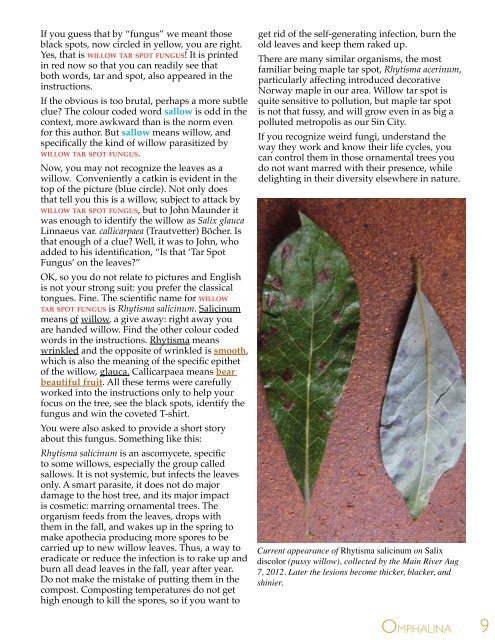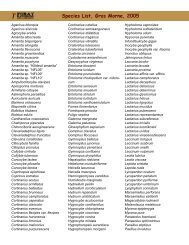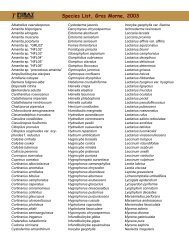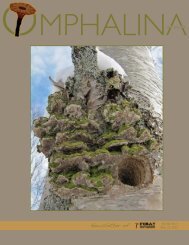Newsletter of - Foray Newfoundland and Labrador
Newsletter of - Foray Newfoundland and Labrador
Newsletter of - Foray Newfoundland and Labrador
Create successful ePaper yourself
Turn your PDF publications into a flip-book with our unique Google optimized e-Paper software.
If you guess that by “fungus” we meant those<br />
black spots, now circled in yellow, you are right.<br />
Yes, that is WILLOW TAR SPOT FUNGUS! It is printed<br />
in red now so that you can readily see that<br />
both words, tar <strong>and</strong> spot, also appeared in the<br />
instructions.<br />
If the obvious is too brutal, perhaps a more subtle<br />
clue? The colour coded word sallow is odd in the<br />
context, more awkward than is the norm even<br />
for this author. But sallow means willow, <strong>and</strong><br />
specifi cally the kind <strong>of</strong> willow parasitized by<br />
WILLOW TAR SPOT FUNGUS.<br />
Now, you may not recognize the leaves as a<br />
willow. Conveniently a catkin is evident in the<br />
top <strong>of</strong> the picture (blue circle). Not only does<br />
that tell you this is a willow, subject to attack by<br />
WILLOW TAR SPOT FUNGUS, but to John Maunder it<br />
was enough to identify the willow as Salix glauca<br />
Linnaeus var. callicarpaea (Trautvetter) Böcher. Is<br />
that enough <strong>of</strong> a clue? Well, it was to John, who<br />
added to his identifi cation, “Is that ‘Tar Spot<br />
Fungus’ on the leaves?”<br />
OK, so you do not relate to pictures <strong>and</strong> English<br />
is not your strong suit: you prefer the classical<br />
tongues. Fine. The scientifi c name for WILLOW<br />
TAR SPOT FUNGUS is Rhytisma salicinum. Salicinum<br />
means <strong>of</strong> willow, a give away: right away you<br />
are h<strong>and</strong>ed willow. Find the other colour coded<br />
words in the instructions. Rhytisma means<br />
wrinkled <strong>and</strong> the opposite <strong>of</strong> wrinkled is smooth,<br />
which is also the meaning <strong>of</strong> the specifi c epithet<br />
<strong>of</strong> the willow, glauca. Callicarpaea means bear<br />
beautiful fruit. All these terms were carefully<br />
worked into the instructions only to help your<br />
focus on the tree, see the black spots, identify the<br />
fungus <strong>and</strong> win the coveted T-shirt.<br />
You were also asked to provide a short story<br />
about this fungus. Something like this:<br />
Rhytisma salicinum is an ascomycete, specifi c<br />
to some willows, especially the group called<br />
sallows. It is not systemic, but infects the leaves<br />
only. A smart parasite, it does not do major<br />
damage to the host tree, <strong>and</strong> its major impact<br />
is cosmetic: marring ornamental trees. The<br />
organism feeds from the leaves, drops with<br />
them in the fall, <strong>and</strong> wakes up in the spring to<br />
make apothecia producing more spores to be<br />
carried up to new willow leaves. Thus, a way to<br />
eradicate or reduce the infection is to rake up <strong>and</strong><br />
burn all dead leaves in the fall, year after year.<br />
Do not make the mistake <strong>of</strong> putting them in the<br />
compost. Composting temperatures do not get<br />
high enough to kill the spores, so if you want to<br />
get rid <strong>of</strong> the self-generating infection, burn the<br />
old leaves <strong>and</strong> keep them raked up.<br />
There are many similar organisms, the most<br />
familiar being maple tar spot, Rhytisma acerinum,<br />
particularly affecting introduced decorative<br />
Norway maple in our area. Willow tar spot is<br />
quite sensitive to pollution, but maple tar spot<br />
is not that fussy, <strong>and</strong> will grow even in as big a<br />
polluted metropolis as our Sin City.<br />
If you recognize weird fungi, underst<strong>and</strong> the<br />
way they work <strong>and</strong> know their life cycles, you<br />
can control them in those ornamental trees you<br />
do not want marred with their presence, while<br />
delighting in their diversity elsewhere in nature.<br />
Current appearance <strong>of</strong> Rhytisma salicinum on Salix<br />
discolor (pussy willow), collected by the Main River Aug<br />
7, 2012. Later the lesions become thicker, blacker, <strong>and</strong><br />
shinier.<br />
OMPHALINA<br />
9





